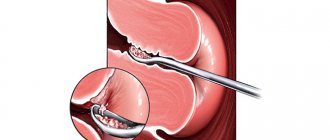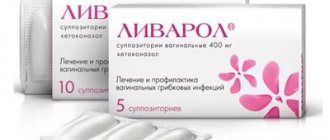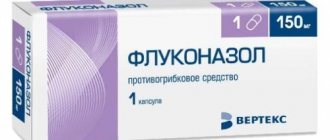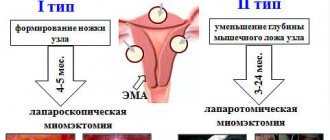How long does it take for fluconazole tablets to work in women?
Fluconazole is a common antifungal agent and is of synthetic origin. Belongs to the pharmaceutical group of triazoles, used for the treatment and prevention of thrush, mycoses and some other pathologies.
How long does it take for Fluconazole to start working? The drug begins to work 1.5 hours after use, and the therapeutic effect in many patients is observed after different times, which is due to the individual characteristics of the body and the specific disease.
Composition and description
The drug is produced in capsule and tablet form, in the form of a gel, syrup, solution for intravenous use, and suppositories. The main active ingredient is the same name of the drug. The capsules contain potato starch, calcium and magnesium stearate as auxiliary ingredients. The tablets contain lauryl sulfate.
You can buy different dosages of the medicine - 0.1 g, 0.05 g and 0.15 g. The capsules are characterized by a blue tint; inside there is a powder with a granular structure - the color is white or slightly yellowish - a variant of the norm. The medicine is sold in cardboard packs containing a blister.
For information, Fluconazole is used as an antifungal drug that has high biological activity against various microorganisms of the Candida spp group, cryptococci, Trichophytum spp and Microsporum spp. In addition, it has a detrimental effect on pathogens that cause mycoses - the dimorphic fungi Blastomyces dermatitidis and Histoplasma capsulatum.
After taking Fluconazole, there is a detrimental effect on fungal enzymes. The active substance blocks the transformation of ergosterol in the cells of pathogenic microorganisms. Under the influence of the drug, an increase in the permeability of the cell membrane and inhibition of the process of pathogen activity are observed.
After taking capsules/tablets, the substance fluconazole is absorbed in the human gastrointestinal tract. How long does it take for it to start working? It is difficult to answer this question accurately, since the effect of any medication depends on the individual physiological characteristics of the body. The pills help some people quickly, while others have to wait a certain time.
According to the instructions, the maximum concentration of fluconazole is detected eight hours after use, but in reality the component begins to work earlier.
One tablet is effective for three days, so the symptoms should be completely eliminated during this time.
In medical practice, special treatment regimens with Fluconazole are used, which take into account precisely this time period, that is, re-use no earlier than after 72 hours.
Instructions for use of the drug
According to doctors, the drug is quite effective against various strains of pathogenic and opportunistic microbes, therefore it is often used in the treatment of various pathological processes.
Indications include:
- Infectious diseases that develop as a result of abnormal fungal activity;
- Oral thrush;
- Atrophic candidiasis of the mouth (this pathology is characteristic of patients who have dentures);
- Non-invasive bronchopulmonary infections;
- Genital thrush (vaginal candidiasis, relapse of the disease);
- Prevention of any type of thrush;
- Onychomycosis;
- Cryptococcosis;
- Deep forms of endemic mycoses, etc.
The drug, which acts relatively quickly, must be taken orally or administered intravenously (only in a medical institution by infusion at a rate of up to 10 ml in 60 seconds).
Important: when Fluconazole is combined with hypoglycemic drugs that are sulfonylurea derivatives, there is an increase in the half-life of the drug, so there is a certain risk of developing a hypoglycemic state (a sharp decrease in glucose concentration to an extremely low value).
Instructions for use:
- Disseminated candidiasis and candidemia. The first time, 0.4 g is taken, then the dose is reduced to 0.2 g. The generalized form in childhood is treated at the rate of 5-10 mg per kilogram of body weight.
- Oropharyngeal thrush. The dosage ranges from 0.05 g to 0.1 g every day for several weeks.
- Atrophic thrush of the oral cavity. Take 0.05 g once a day. Therapy must be combined with the use of local agents used to treat prostheses. The therapeutic course varies from 2 to 4 weeks.
- To prevent relapse of oropharyngeal thrush in patients with immunodeficiency, take 0.15 mg once every seven days. In childhood, the dosage is calculated as follows: 3 mg of medication per 1 kilogram of weight. The first time they give a double dose.
- Cryptococcal infectious pathologies. It is recommended to take 0.2-0.4 g once a day. For the first time, take 0.4 g, subsequent days 0.2 g. The treatment course varies from 6 to 8 weeks.
- For infectious pathologies of the skin, take 0.15 g every 7 days or 0.05 g every day for a week. The duration of therapy is no more than six weeks.
- Patients with a history of pityriasis versicolor should take 0.3 g once every seven days for a course of 14 days.
- For onychomycosis, take 0.15 g every 7 days. The duration of the course is until the new nail plate grows.
Source: https://medistok.ru/medicina/flukonazol-cherez-skolko-dejstvuet-tabletka-u.html
Genital herpes
If we talk about why fluconazole does not help with thrush, then the reason may be genital herpes. This is a common viral infection that is sexually transmitted. The disease is caused by the herpes simplex virus (HSV).
Herpes may be accompanied by scanty discharge, itching, and pain during sexual intercourse. Herpes in many cases causes chronic candidiasis, which is difficult to treat. When getting rid of thrush, you will first have to treat the herpes infection.
It is especially necessary to undergo treatment before planning a pregnancy, since many drugs will be banned after conception. In addition, HSV can lead to malignant tumors of the cervix.
Another reason why tablets for thrush do not help lies in the partner. All sexually transmitted infections must be treated together with the man, and candidiasis is precisely this type of disease.
How long does it take for Fluconazole tablets to work after taking them?
Fluconazole is a common antifungal agent and is of synthetic origin.
Belongs to the pharmaceutical group of triazoles, used for the treatment and prevention of thrush, mycoses and some other pathologies. How long does it take for Fluconazole to start working? The drug begins to work 1.5 hours after use, and the therapeutic effect in many patients is observed after different times, which is due to the individual characteristics of the body and the specific disease.
Treatment with fluconazole
So, almost all women experience episodes of vaginal dysbiosis, many of which are actually accompanied by candidiasis, which in some cases is successfully treated with fluconazole.
Thus, fluconazole is prescribed by a doctor to treat bacterial candidiasis.
After the fungus dies, the vaginal mucosa is open to colonization, which can lead to a repeat episode of candidiasis or bakvaginosis.
To resolve this situation, after prescribing fluconazole, experienced doctors often recommend vaginal forms of probiotics that compensate for the flora and restore normal vaginal acidity. In this case, the risk of chronicity of the process is significantly reduced.
Release forms
Fluconazole has several forms of release (some manufacturers have everything).
- Capsules. There are No. 1, No. 5, No. 7, the standard dosage is 50 and 150 mg;
- Solution for intravenous administration. It is used in a hospital to treat generalized forms of fungal infection (thrush is rarely treated in this way);
- Syrup. Fluconazole in the form of syrup is prescribed to children, as well as to persons who have problems with swallowing. The dosage is 3 mg/kg body weight/day;
- Pills. This form of release is mainly indicated for the treatment of chronic forms of the disease. Capsules are considered the more preferable form in terms of drug bioavailability.
Schemes for the use of fluconazole in the treatment of vaginal candidiasis
Each specialist has their own. This is due not only to specific indications for a particular patient, but also to a large extent to the clinical preferences of a particular doctor, and also depends on the level of qualifications of the specialist.
Example of a fluconazole treatment regimen
Theoretically, with each episode of thrush, the doctor should do a culture of the flora, find out which antimycotic/antibiotic this flora is sensitive to, and only then prescribe this or that remedy.
In practice, doctors often prescribe complex drugs or regimens that, in addition to fluconazole, also contain an antibiotic (just to be sure).
This is not entirely humane to the entire body; it significantly reduces immunity, but it almost certainly treats dysbacteriosis. However, this approach increases the risk of recurrence of the condition in the future.
For chronic forms of the disease, postmenopause or immune deficiency, the following treatment regimens are practiced:
- A single dose of 150 mg capsule is the standard for the prevention of candidiasis after antibiotics are prescribed;
- Two days 150 mg;
- 150 mg capsule daily for 3 days;
- Weekly course of therapy 150 mg;
- 1 capsule every three days 2, 3 and 5 times.
For chronic candidiasis, 1 capsule is recommended weekly for a long time (for 6 months or longer).
In addition, there is the practice of 3 days after 3 days, as well as “author’s” treatment regimens. Doctors at dermatovenerological dispensaries are particularly sophisticated in this area - they combine fluconazole with a number of quite severe (for the liver and kidneys) drugs.
An example of such a “shock” therapy is the drug safocid, which includes azithromycin (an antibiotic), fluconazole (an antimycotic) and secnidazole (against chlamydia and trichomonas).
For example, with persistent thrush after 50 years in women (postmenopause), it is better not to take fluconazole every week, but to install an intrauterine device once, which corrects estrogen levels. As a result, the vagina will acidify naturally, and thrush will stop bothering you.
Illiterate, uncontrolled use of fluconazole quite often leads to the emergence of multi-resistant strains of fungus that are resistant to almost all known groups of drugs.
Fluconazole is also prescribed for men (sexual partners). The fact is that balanitis of a fungal nature (damage to the head of the penis) requires treatment, despite the fact that it is often asymptomatic. If a fungal infection again enters the vagina, the flora of which has been killed by an antibiotic, and the fungus by fluconazole, the meaning of thrush treatment is lost.
Treatment of a sexual partner
What else do you need to know?
Treatment with Fluconazole leads to the fact that the disease goes away within two or three days after taking the drug. However, to confirm the result, the doctor will prescribe a microflora test. This is the only way to be sure of a complete cure for Candida.
If Fluconazole is prescribed for thrush, the price of the drug is affordable for everyone. The cost of one capsule is from 15 rubles.
The active substance is also included in other antifungal drugs. The analogues are as follows:
Source: https://AptekaTamara.ru/drugoe/flukonazol-svechi.html
Maybe it's not candidiasis
If Fluconazole does not help with thrush, the reason may be an incorrect diagnosis. In the modern world, many people do not find time for a doctor, and the state of public medicine leaves much to be desired. Usually women grab the first drug they come across at the pharmacy, without understanding the symptoms.
STDs include:
- gonorrhea,
- chlamydia,
- trichomoniasis,
- syphilis.
Mycoplasmosis and ureaplasmosis are not considered sexually transmitted diseases. Mycoplasma, ureaplasma, and gardnerella live in the body of every woman, but if they go wrong they can cause bacterial vaginosis. In this case, restoration of the microflora will be required.
Candida fungi are present in the body of every woman. Gardnerella and other microorganisms are also present in the body. Normally they do not cause concern. When immune failure occurs, the number of bacteria increases. Discharge and inflammation appear.
An increase in the number of Candida is often associated with intestinal dysbiosis. Intestinal problems arise due to improper antibiotic therapy. Proper treatment usually does not cause intestinal problems. Antibacterial therapy was previously carried out simultaneously with antifungal therapy to avoid the development of candidiasis.
When treating candidiasis, it is important to establish the root cause, that is, to find out what in the body led to immunodeficiency.
Fluconazole for thrush: instructions for use
When clinicians talk about effective antimycotics, they primarily mention the group of azoles.
They are effective in the treatment of all forms of candidiasis (generalized, urogenital, oral, dermatomycosis). A huge plus is that in case of acute infection, it is enough to take 1 tablet (150 mg).
In first place in popularity is Fluconazole, a systemic antifungal drug that has been extensively studied.
Fluconazole is suitable for men, women and children for the treatment of candidiasis of all organs and tissues where there is mucous epithelial tissue. However, the option of resistance, and therefore ineffectiveness, is also possible. The nuances are determined by the doctor. We offer instructions for the use of Fluconazole in different periods of thrush, how long it takes to act, reviews from doctors and patients about treatment with this drug.
Why is Fluconazole effective against thrush?
The drug is classified as an antifungal agent of the 1st generation class of triazole compounds.
Fluconazole provides a pronounced antimycotic effect by inhibiting the synthesis of fungal styrenes, preventing the conversion of lanosterol to ergosterol, without which degranulation of the cell membranes of pathogenic microorganisms occurs and, as a result, their death.
It has a depressing effect on fungal enzymes dependent on cytochrome P-450, but does not suppress functionally similar biologically active substances of the human body, i.e. it does not burden the activity of the liver, and is well and quickly absorbed.
The active component is insensitive to the action of gastric juice, therefore its bioavailability is equally high (≥ 90%) in all forms of release.
Reception does not depend on the time of food consumption.
Plasma protein binding occurs by only 11-12%, which ensures high efficiency and bioavailability. The half-life is ≈ 30 hours, excreted in the urine, with 80% unchanged.
It is these properties that ensure a high degree of effectiveness in treating urogenital mycoinfections and candidiasis in particular.
Pharmacological forms
- IV solution with an active ingredient concentration of 200 mg / 100 ml volume;
- powder for preparing suspension (Diflucan);
- Fluconazole tablets containing 50, 100 or 150 mg of the active substance (for example, Mikoflucan, it is used for long courses of treatment of chronic infection);
- gel with a concentration of 5 mg / 1 g volume (Flucorem);
- syrup used at a dosage of 3 mg/kg body weight per day (Mikomax; aimed at children and patients with swallowing problems);
- capsules with a concentration of the active component of 50 mg (Flunol), 100, 150 (Flucomicide Sediko) and 200 mg (Forkan, Ciskan), number per package: 1, 5, or 7 (recommended if you need quick and more complete, in terms of bioavailability , result).
Due to the variety of forms, the possibility of multifactorial influence on the infectious agent is possible, which leads to a good therapeutic effect.
Side effects are described in detail in the instructions. Judging by the reviews, gastrointestinal problems occur more often than others: nausea, bloating, gurgling, mild abdominal pain, diarrhea. In isolated cases - migraine, rash, hair loss.
Be sure to read the answer to the question: “Is it possible to have sex with thrush?”.
Why do you need an Esmarch mug when treating thrush >>.
Instructions for use of Fluconazole
For the fair half of humanity, therapy for candidiasis seems to be a long-term process. This is due to the need to treat large areas of affected tissue and, morphologically, the conservative structure of the reproductive system.
How to use? The treatment regimen with Fluconazole tablets or capsules depends on the form of the disease, clinical experience, preferences and qualifications of the specialist.
The daily dose is adjusted taking into account the dynamics and severity of the fungal infection.
Treatment, which requires repeated use, lasts until a clinical and laboratory effect is achieved (complete disappearance of symptoms).
Incompletely cured candidiasis is fraught with a recurrence of the active infectious process. You can take the drug until the results of culture or other laboratory tests are obtained, followed by the introduction of antimicrobial drugs of choice into the regimen.
How to take for mild or moderate symptoms: Fluconazole dosage – 150 mg (capsule), single dose. This applies to cases of new or uncomplicated pathology.
How to drink if there are concomitant diseases and with severe symptoms: it is recommended to take two 150 mg capsules with a break of 72 hours (on the first and fourth days).
Regimen for recurrent candidiasis in women: the dosage is increased to three tablets of 150 mg. Drink 1 pc on the first, fourth and seventh days. Next, maintenance anti-relapse therapy is carried out: 150 mg every week for six months.
- Readers ask the question how much Fluconazole to take for thrush when treating a married couple.
We answer:
✔ women are recommended the above scheme: three-day course + Fluconazole tablet weekly, 6 months;
✔ for men, take a one-time dose of 150 mg and prophylactically +1 weekly for six months.
- How to take during pregnancy.
The drug is prescribed only in cases of severe or life-threatening fungal infections. During lactation it is necessary to stop breastfeeding.
The remedy is considered classic and the most justified, in all senses of use, for the treatment of candidiasis in men.
Recommended dosage : 150 mg once + rubbing Flucorem. Local medications are applied to areas of fungal infection, including healthy areas of the skin, once a day (5-7 days).
More details>>
How long does it take for thrush to go away after taking Fluconazole?
Significant improvement occurs on the second day after administration, almost all symptoms disappear. But this does not mean that the disease has passed. Only after the tests that need to be taken upon completion of the course prescribed by the doctor can we say with confidence that there is no more thrush.
For symptoms of candidiasis that has spread to the skin, a first dose of 150 mg is recommended; in parallel, local application of a cream or gel with the same active ingredient is used on the damaged area. To consolidate the effect, on the third day you need to take another tablet without changing the dosage. Continue topical use until skin symptoms disappear completely.
With chronic thrush, treatment takes longer.
According to the classical scheme, 150 mg per oz is prescribed at the following time intervals:
- first appointment;
- after three days;
- in two weeks;
- for six months, take a tablet once a month.
Gynecologists advise women to take fluconazole maintenance on the first day of the menstrual cycle.
An unambiguous therapeutic requirement is a simultaneous course of treatment for thrush in both sexual partners, since contact transmission of the disease has been proven.
Fluconazole for thrush: reviews from doctors
According to doctors, the antimycotic in question is characterized by 7 main advantages.
- Penetrates deeply into tissues, providing a fungicidal effect at all stages of fungal development.
- It has a wide therapeutic window, so taking the drug for thrush provides a combined antimycotic effect in the presence of combined infections.
- Release in different dosages allows you to adjust the duration of treatment depending on the age and condition of the patient.
- It has a high safety threshold and is approved for use in children over 4 years of age.
- Simple and easy to take.
- Affordable.
- Available in almost all pharmacies.
We offer our readers excerpts from medical reviews.
Alexey Cherepanov, obstetrician-gynecologist: the prescription of this antimycotic is a time-tested practice for the treatment of vulvovaginal candidiasis. There are practically no misfires if the patient strictly adheres to the dosages and prescribed dosage regimen.
Elena Galtseva, clinical pharmacist: dosage forms based on fluconazole are the permanent sales leaders of the domestic pharmaceutical market in the niche of antifungal drugs.
Sergey Reznik, obstetrician-gynecologist: my gold standard in the treatment of uncomplicated vaginal candidiasis is the prescription of drugs whose active ingredient is fluconazole. I recommend Fucis to patients.
If stepwise therapy is necessary, including local action, a cream of the same name is convenient. The result: a proven clinical effect, a clear picture of recovery.
Alena Gudkova, gynecologist: if, based on the test results, I come across thrush, I prescribe Fluconazole. Selection criteria: speed and guarantee of a therapeutic effect, especially since only 5% of fungal strains are resistant to the active component.
Does Fluconazole help with thrush? Patient reviews
The rapid effect of the medicine on unpleasant symptoms led to mostly positive reviews. Patients are also pleased with the price - 1 capsule of 150 mg costs about 11 rubles.
Karina, Moscow
My friend and I treated candidiasis at the same time. We have different doctors, but both recommended medications with the same active ingredient. My friend was treated with Futsis, I was treated with Fluconazole. Absolutely the same positive effect. The drug is great, but why pay more?
Lena, Ufa
Reliable, at an unexpectedly happy price. This is an excellent domestic analogue of expensive imported drugs. It is great that pharmacies support domestic manufacturers by offering vital medications at an affordable price.
Nelli, Obninsk
I’ve heard different reviews about the medicine, most of them are good, they say, it’s inexpensive and helps a lot. Personally, for a long time I somehow carried past troubles. The diagnosis of thrush left unpleasant memories. I immediately went to the doctor and got tested. She was treated as prescribed in the simplest “Nashen” way - clearly, quickly, cheaply, angrily - in the good sense of the word.
Alina, Bataysk
If I could, I would sing about a miracle drug, but otherwise, I’ll just say: cool! He helped very quickly and the disease has not bothered me for three years now.
Serafima, Sevastopol
I am very angry with candidiasis, fluconazole will tear them apart! Stay positive!
Which fluconazole drug should I buy?
There are about 20 synonyms on the pharmaceutical market - trade names that differ in the form of release, the concentration of the active component, and auxiliary elements of the composition.
Numerous trade names confuse people.
To make it easier to navigate the pharmacy, pay attention to the analytical review, which includes the names, dosages, purposes and prices of the main varieties.
As can be seen from the annotations, all remedies cover similar pathologies of mycotic infections. The given trade names do not exhaust the list of manufactured medicines containing this active ingredient; only Russian companies offer 17 trade names of decent quality.
Source: https://webmolochnica.ru/flukonazol-pri-molochnice-kak-prinimat.html
Additional measures
When treating women, they are interested not only in how long it takes for Fluconazole to act for thrush, but also how quickly the itching and inflammation of the vagina (colpitis) will disappear. The drug acts gradually, usually in the first day, but the itching needs to be relieved instantly.
To eliminate discomfort, Epigen Intim spray is additionally prescribed. The spray is used up to 4 times a day, spraying 1-2 times inside the vagina. The spray will relieve itching and also help restore normal vaginal microflora, disturbed by taking antifungal medications. To completely restore the microflora, use the spray for 10 days.
During pregnancy, systemic drugs are not used due to their toxicity. The use of local medications (Pimafucin) is allowed. Additionally, the vagina can be treated with furatsilin solution.
Non-pregnant women can use drugs with nystatin and clotrimazole for local treatment. For local treatment, suppositories and sometimes ointments and gels are usually used.
Speaking about how long it takes for thrush to go away after taking fluconazole, you should remember that if in the first days there is no improvement and reduction in symptoms, the drug may not be suitable. In this case, Fluconazole is replaced by other antifungal drugs.
How long does fluconazole last?
Fluconazole is a common antifungal agent and is of synthetic origin. Belongs to the pharmaceutical group of triazoles, used for the treatment and prevention of thrush, mycoses and some other pathologies.
How long does it take for Fluconazole to start working? The drug begins to work 1.5 hours after use, and the therapeutic effect in many patients is observed after different times, which is due to the individual characteristics of the body and the specific disease.
Contraindications and side effects of Fluconazole
The drug is prescribed with extreme caution if there is a history of liver disease or superficial fungal infections. Based on the results of laboratory tests, the doctor may adjust the dosage downward.
Source: https://doctor-grebnev.ru/info/skolko-vremeni-dejstvuet-flukonazol/
Fluconazole analogs
Drug analogues include drugs - Vfend, Medoflucon, Intracon, Mikosist, Kandizol, Vero-Fluconazole, Flucostat, Diflucan, Nystatin, Diflazon, Fluconazole with the Teva prefix, Fluconazole Stada, etc.
Fluconazole really helps against various diseases, although many are familiar with the drug as a medicine for quickly relieving the symptoms of thrush.
In some clinical situations the drug is not suitable, so the doctor selects a suitable analogue.
Analogues of the antifungal agent Fluconazole (brief description):
- Nystatin is an antifungal drug, the active component is the same name. You can buy ointment, tablets, and suppositories at the pharmacy. It should not be used against the background of chronic and acute pancreatitis, with ulcerative pathologies of the gastrointestinal tract, or liver dysfunction. The dose is selected individually, depending on the specific disease and age of the person.
- Diflucan contains fluconazole, its dosage is 0.05 g, 0.1 g and 0.15 g - tablet form. It has a higher price, but no differences were found in the therapeutic effect. Has contraindications: childbearing, breastfeeding, hypersensitivity.
- Medoflucon consists of fluconazole and auxiliary components. Has similar indications for use. The difference is that this drug should not be given to children under 18 years of age.
Note: during treatment with Fluconazole and its analogues, you must avoid drinking alcohol. The combination of ethanol + fluconazole is a dangerous combination for the liver.
Fluconazole is a fairly popular drug that helps cure thrush, candidiasis of various localizations, and other diseases. You can buy it at a pharmacy, a doctor’s prescription is not required, the price for one capsule is about $0.8-1.
Source: https://parazitron.ru/preparaty/cherez-skolko-deystvuet-flukonazol.html
The drug didn't help
It happens that fluconazole does not help with thrush, what should you do in this case? In approximately 10% of cases, thrush is difficult to treat, and in 2% of women the drug does not help at all. The ineffectiveness of the drug is explained by the fact that some fungi of the genus Candida are resistant to the medication. In this case, culture will be required in the laboratory to identify the pathogen.
If fungi are resistant to the Fluconazole component, other drugs are used: Miconazole, Nystatin, Polygynax, Clotrimazole, Mikosist, capsules with fenticonazole.
How long does it take for fluconazole to work?
Candidiasis is an unpleasant disease that affects not only the mucous membranes, but also the skin. If left untreated, the patient may experience serious complications. Fungicides are used for therapy. Many patients are interested in how long it takes for Fluconazole to work. This allows you to accurately calculate the effectiveness and course of therapy, as well as achieve stable remission in the chronic form of the pathology.
Fluconazole is an antifungal drug that is highly effective and modestly priced (only 15-30 rubles).
Features of the drug use
The drug works well against thrush. Moreover, you can get rid of the acute form of the pathology faster than the chronic one. In the first case, the drug begins to work after taking the first tablet (150 mg). The chronic form requires several uses of tablets.
Capsules will be more effective if taken together with vaginal suppositories or ointment for topical use. The maximum concentration of the main substance is observed within 30 minutes - 1 hour after administration .
How quickly Fluconazole acts in the treatment of candidiasis depends on the characteristics of the patient’s body, the severity of the pathology, and the presence of concomitant diseases. The functionality of the stomach and intestines, as well as the use of other medications, are also taken into account.
In chronic forms of the disease, the course of therapy lasts at least 2 weeks. Fluconazole begins to act on the first day, but only the symptoms of the disease are eliminated. You can completely get rid of the infection only if you take not one dose of the drug, but at least 3.
How quickly does the product work and how much should you take it?
The effect of Fluconazole depends on the type of disease. In general, the product has a high level of bioavailability of 90%. The disappearance of symptoms occurs within a day. But this does not mean that treatment can be completed.
You need to take the pills from several days to a couple of weeks:
- Candidiasis of the oral cavity and mucous membranes of the throat lasts 7-14 days;
- With atrophic candidiasis, the medicine begins to act quickly - on the very first day.
The duration of therapy is 2-4 weeks; - To prevent candidiasis, people with severe immunodeficiency can take 1 tablet every 7 days;
- Cryptococcal meningitis requires high doses of Fluconazole daily for 2 months;
- It will take 2-4 weeks to eliminate skin diseases. At the same time, Fluconazole will also act from the first day;
- Pityriasis versicolor is treated for 14 days;
- For vaginal thrush, a single dose of the drug is sufficient. To prevent its occurrence, you can take another capsule after a month.
Fluconazole will act for a long time against thrush. The effect after administration lasts 72 hours, after which repeated use of the drug is required.
Do other medications affect the speed of action of the drug?
There are drugs that can slow down the effect of Fluconazole. Although a single dose together with another drug will not give a significant effect.
With the constant use of Fluconazole with other drugs, the following effect is noted:
- combination with Warfarin leads to prolongation of the prothrombin time of the main drug;
- when used together with Hydrochlorothiazide, the concentration of Fluconazole in the blood increases and it begins to act faster.
Despite the positive effect that the presented drug gives, you should not take it on your own. This remedy will not always act detrimentally against pathogenic microflora. Sometimes it gives side effects.
Sources:
Vidal : https://www.vidal.ru/drugs/fluconazole__12803 GRLS : https://grls.rosminzdrav.ru/Grls_View_v2.aspx?routingGu >
Found a mistake? Select it and press Ctrl + Enter
Fluconazole is a common antifungal agent and is of synthetic origin. Belongs to the pharmaceutical group of triazoles, used for the treatment and prevention of thrush, mycoses and some other pathologies.
How long does it take for Fluconazole to start working? The drug begins to work 1.5 hours after use, and the therapeutic effect in many patients is observed after different times, which is due to the individual characteristics of the body and the specific disease.
Copy problem
Domestic capsules are much cheaper than the original. Fluconazole has become available to all segments of the population. The problem was that it was possible to register a drug created not only on the model of the original Diflucan, but also on its generics.
The discrepancy in composition turns out to be significant if the new drug is manufactured from the fifth or tenth copy of the original. In addition, there is a difference in the base, auxiliary components, and capsule composition.
Generic drugs can be either bioequivalent to the original drug or different from it. Fluconazole in different pharmaceutical products differs in quality. Also, despite the same formula of the active substance, the drugs may differ in dosage.
Whether Fluconazole helps with thrush depends on the quality of the purchased generic and the individual characteristics of the body. For some, a cheap analogue will be enough. Some girls prefer not to overpay for Diflucan, buy medications for 35-40 rubles and cope with candidiasis quite effectively.











